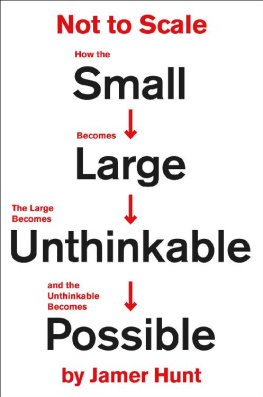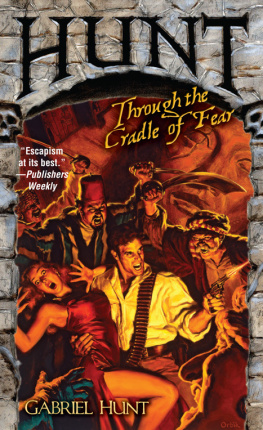Jamer Hunt - Not to Scale
Here you can read online Jamer Hunt - Not to Scale full text of the book (entire story) in english for free. Download pdf and epub, get meaning, cover and reviews about this ebook. year: 2020, publisher: Grand Central Publishing, genre: Romance novel. Description of the work, (preface) as well as reviews are available. Best literature library LitArk.com created for fans of good reading and offers a wide selection of genres:
Romance novel
Science fiction
Adventure
Detective
Science
History
Home and family
Prose
Art
Politics
Computer
Non-fiction
Religion
Business
Children
Humor
Choose a favorite category and find really read worthwhile books. Enjoy immersion in the world of imagination, feel the emotions of the characters or learn something new for yourself, make an fascinating discovery.
- Book:Not to Scale
- Author:
- Publisher:Grand Central Publishing
- Genre:
- Year:2020
- Rating:4 / 5
- Favourites:Add to favourites
- Your mark:
- 80
- 1
- 2
- 3
- 4
- 5
Not to Scale: summary, description and annotation
We offer to read an annotation, description, summary or preface (depends on what the author of the book "Not to Scale" wrote himself). If you haven't found the necessary information about the book — write in the comments, we will try to find it.
Not to Scale — read online for free the complete book (whole text) full work
Below is the text of the book, divided by pages. System saving the place of the last page read, allows you to conveniently read the book "Not to Scale" online for free, without having to search again every time where you left off. Put a bookmark, and you can go to the page where you finished reading at any time.
Font size:
Interval:
Bookmark:

Copyright 2020 by Jamer Hunt
Cover design by Oliver Munday. Cover copyright 2020 by Hachette Book Group, Inc.
Hachette Book Group supports the right to free expression and the value of copyright. The purpose of copyright is to encourage writers and artists to produce the creative works that enrich our culture.
The scanning, uploading, and distribution of this book without permission is a theft of the authors intellectual property. If you would like permission to use material from the book (other than for review purposes), please contact permissions@hbgusa.com. Thank you for your support of the authors rights.
Grand Central Publishing
Hachette Book Group
1290 Avenue of the Americas, New York, NY 10104
grandcentralpublishing.com
twitter.com/grandcentralpub
First Edition: March 2020
Grand Central Publishing is a division of Hachette Book Group, Inc. The Grand Central Publishing name and logo is a trademark of Hachette Book Group, Inc.
The publisher is not responsible for websites (or their content) that are not owned by the publisher.
The Hachette Speakers Bureau provides a wide range of authors for speaking events. To find out more, go to hachettespeakersbureau.com or call (866) 376-6591.
Library of Congress Cataloging.in.Publication Data has been applied for.
ISBNs: 978-1-5387-1588-8 (hardcover), 978-1-5387-5134-3 (international trade), 978-1-5387-1-5895 (ebook)
E3-20200109-JV-NF-ORI
To Cynthia Holt Hunt
Explore book giveaways, sneak peeks, deals, and more.

B ubble levels and outdoor thermometers. Compasses and alarm clocks. We used to make these in factories and keep them in our toolboxes and on our bedside tables. Today, they are utilities, bundled for free on our smartphones, just a thumb swipe and a finger tap away. As children, we cobbled together compasses from a piece of cork, a sewing needle, and a magnet; or built a sundial clock from sticks and stones. Comprised of microcircuits, electrons, lines of code, and glowing pixels, the compass and watch in our smartphones might as well have been made by tiny elves using pixie dust. The disappearance of these mechanical tools into the inner workings of the smartphone is a transformation barely short of magic. Few of us would know how, let alone dare, to tinker with the compass in our phone. Where would we even find it whatever it is?
In some significant way each of these instrumentsthe level, the thermometer, the compass, and the clockalso helps us to navigate scale. Each organizes invisible forcesorientation, temperature, direction, and timeinto perceptible ones. From sensation comes measurement; from chaos comes order. The bubble, or spirit, level plumbs surfaces, situating us in the universe. The physics of its operation is utterly self-evident: A bubble of air trapped in a glass tube filled with colored ethanol (the spirit) lists left or right, up or down, depending on the levelness of the surface. When the bubble comes to rest evenly between the machine-inscribed marks, or scale, things are level, or plumb. A thermometer is similarly straightforward: A small, sealed, glass tube is filled with a dab of mercury. Mercury, being sensitive to temperature, expands as it warms up and contracts as it cools. Once the tube is oriented vertically, the mercury rises as the temperature rises and falls as it falls. Graduated markings add relative degrees of quantitative precision, helping us to decide whether its a day for a light sweater or a heavier coat. In ways that were casually reassuring, the level, thermometer, compass, and alarm clock all evidenced their mechanics. We could relate to their operation. They each interacted with a seemingly ungovernable set of forces and made them knowable.
By turning these tools into functions, and by embedding them deep into the guts of a smartphone, engineers and designers transformed a relatively dumb object, the cellular phone, into a multifunction Swiss Army knife on steroids. As of 2019 Apples App Store was home to more than two million appsthats two million different configurations of functions that ones smartphone could deliver. This dematerialization of knowable, physical things into infinitesimal, glowing pixels has transformed not only our economies and lives over the past half century but has also remade our perceptual universe. And where people such as travel agents, traffic reporters, and even friends used to provide services to us on the sidewalks and in the storefronts of our communities, they now more likely exist as complex algorithms somewhere within the apps on our smartphones. As we have drifted from a geographically bounded economy based on hard goods and real people to a networked, global one fueled by information, services, software, and artificial intelligence, we are losing touch, quite literally, with the scale of the known world.

Fig. 1.Traditional bubble level.
We spend exceedingly long parts of our days with our eyes and ears immersed in digitally mediated environmentsworking, watching, playing, relaxingbut the physical characteristics of those environments are effectively unrelatable to our human senses. If scale is a means by which we orient ourselves within our environmental surroundings, what happens to us when we cannot touch, smell, taste, hear, or even see their operation? Not to Scale is an X-ray of our present cultural moment. Rooted in the fields of design, technology, and culture, we will bound across science, politics, photography, anthropology, systems thinking, and business innovation in order to demonstrate the pervasive, distorting effects of subtle scalar shifts. Scale is not simply a way to measure the size of things around us. It is a formidable conceptual framework. We shape scale, but scale also shapes us though we scarcely pay heed to it. Thinking and acting through scale, in all of its strange complexity, may be our best strategy for thriving in a dynamically changing world.
Few things should be more self-evident than scale, but it can be one of those concepts that gets more befuddling the longer one stares at it. We usually think of it, in its simplest sense, as a way to assess how big or small things are. The Cambridge Dictionary defines scale as a range of numbers used as a system to measure or compare things. For many, scale is nothing more than a tool for organizing information and collecting facts: Musicians understand scale as a particular scaffold of notes; urban planners use scale to distinguish geographical subunits; and businesses view scale as a means to measure productivity or sales. And the flexibility of the concept of scale allows it to work as effectively for physical properties (length, mass, temperature) as it does for less precisely measurable things (headaches and crushes).

Fig. 2.Digital level.
Through scale we can grasp the invisible: Calendars and clocks locate us across a continuum of astronomical or circadian cycles, marking months and hours and minutes and seconds. Maps and compasses locate us in space. This instrumentation of scale has become so hardwired into our perception that we now feel as though linear time, calendrical dates, and cardinal directions are a natural part of the physical world. In reality, scale is merely a human construct that we layer on top of the things we encounter so that our experiences make greater sense.
Font size:
Interval:
Bookmark:
Similar books «Not to Scale»
Look at similar books to Not to Scale. We have selected literature similar in name and meaning in the hope of providing readers with more options to find new, interesting, not yet read works.
Discussion, reviews of the book Not to Scale and just readers' own opinions. Leave your comments, write what you think about the work, its meaning or the main characters. Specify what exactly you liked and what you didn't like, and why you think so.











